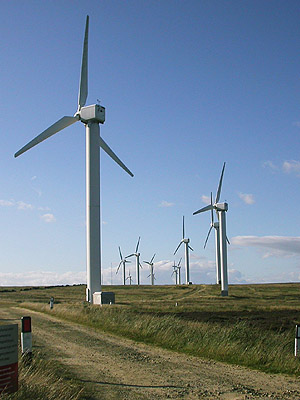

| Wind Turbine proposal for Eakring - threat to wildlife? |
| Proposals earlier this year for a wind farm on the edge of Eakring village, have been met with strong opposition by local residents. | ||
| ............... | ||
| The proposal for four
turbines on land owned by Eakring Farming Ltd and four
more on the old Bilsthorpe pit top, would be one of the
first such proposals for Nottinghamshire - a county which
has so far evaded having turbines situated on any of it's
geographically high points, such as exist in the more
exposed areas of the UK such as the Pennines and along
the west coast. Plans were expected to be submitted in September by Eakring Farming Ltd and Harworth Power Ltd. To fight this proposed development a local action group was formed - The Eakring Turbine Action Group. The group believe that the wind farm will:
The first action taken by the group was to conduct a poll to find out what people thought. The result was that 81% of villagers were found to be against the proposed development. |
 Wind turbines at Ovenden Moor: Photograph by Dave Barker |
|
| ............... | ||
| Wildlife
threat The proposal that the development will affect wildlife, has been a major talking point and I have been asked about this personally by members of the action group, on my walks around the village. In truth and whilst not being in agreement with the wind farm, I was not able to supply any valid argument against the proposals. The site is on land currently being used for growing cereals and Oil-seed Rape, and is used by a minimum number of breeding birds. The potential argument that the Eakring area, is on an important migration route is non-existant. The high number of birds recorded annually, is down to observer coverage alone. Such numbers (and much higher) could easily be achieved from any other similar vantage point within Nottinghamshire. The only real known migration route, is through the Trent Valley. This is used by gulls, terns and wading birds cutting across country during either Spring or Autumn passage. Passerine migration is usually broad-scale and it is only through a few people (in Notts) counting birds during visible migration watches, that lends people to think that they observe from an important migration location. Many birds continue to be killed by power lines, especially in wetland areas or along river valleys and there seems little evidence to support the theory that more are indeed killed by wind turbines. The eyesore factor of a wind farm is definitely a valid one, but much the same protests were aired against electricity pylons many years ago. Nowdays, they pass almost unnoticed. Data use by RPS I have been involved in supplying my own data to RPS, the company who have been surveying the site for most of 2005. The data I hold is unique, being the only such data for the site. My providing it, may have been incorrectly mistaken for my being in favour of the wind farm. The data (including many rare bird and insect species') might potentially provide one of the best forms of factual evidence against the project. Without it, then it could well have been much easier to have obtained the neccessary planning application to go ahead. |
||
| Related links | ||
| .... | ||
| Oil-drilling | The threat of oil-drilling proposals on to the area's wildlife | |
| Hedgerow Loss | How the area has been affected by decades of hedgerow removal | |
| SINC/SSSI Sites | SINC and SSSI sites within the area | |